Guiding a Bird Tour to NFLD and visiting NS
 |
| Atlantic Puffin carrying dandelions for its nest at the colony at Elliston, NFLD - Photo |
I guided a sold out bird tour of a group of 10 people to Newfoundland this June with Avocet Tours. The tour began on June 11th and I left a few days early to scout. I have always wanted to go to this beautiful province. My mom really wanted to go there to see the puffins and landscape and we were planning to make a trip but she got too sick to go. We had hoped we would go after she recovered but sadly that didn't happen. I definitely carried her with me during the trip.
When we landed it was cold only 1C! The next morning it warmed up and was sunny and in the teens. We went straight to see the Pink-footed Goose! I had seen 2 before in Victoria but they had been distant scope views. Seeing one like this up close and so tame was a real treat. They are quite subtly beautiful.
 |
| Pink-footed Goose in St. John's Newfoundland - Photo: Melissa Hafting |
After that we went to Mun Botanical Gardens to see the boreal birds. Here we saw a lovely Yellow-bellied Flycatcher, Blackpoll Warbler, Northern Waterthrushes, Black-and-white Warblers and Blue Jays as highlights. On Oxen Lake we had American Black Ducks, Great Black-backed Gulls, Fox, Swamp and White-throated Sparrows and Common Terns. There was also nesting Tree Swallows. At the park I loved watching Boreal Chickadees and a large flock of White-winged Crossbills feeding on the ground. This is rare for us Vancouverites!
 |
| White-winged Crossbill in St. John's - Photo: Melissa Hafting |
 |
| Boreal Chickadee in Newfoundland - Photo: Melissa Hafting |
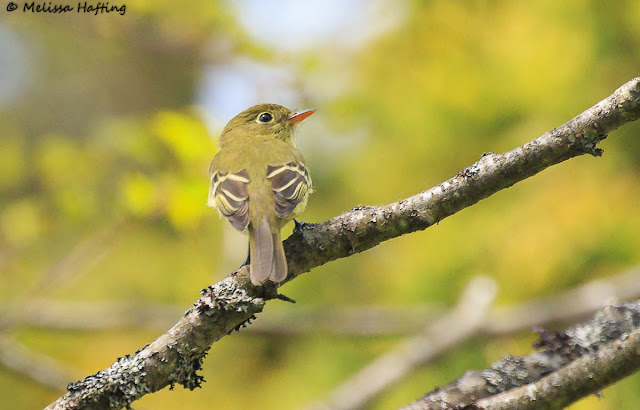 |
| Yellow-bellied Flycatcher in St. John's - Photo: Melissa Hafting |
 |
| Great Black-backed Gull at Oxen Lake - Photo: Melissa Hafting |
 |
| St. Vincent's-St. Stephen's-St. Peter's a great whaling and seabirding spot! |
 |
| Willow Ptarmigan at Cape Pine - Photo: Melissa Hafting |
The next morning we went to Bidgood Park. This is a lovely park where many boreal warblers breed and normally Common Grackles frequent. We did not find a Common Grackle but spotted a Yellow-bellied Flycatcher, Blue Jay, Boreal Chickadees, Hermit Thrush, many spiffy Swamp Sparrows in their breeding plumage, Black-and-white Warblers, Blackpoll Warblers, Wilson's, Yellow and Yellow-rumped Warblers. We were lucky to spot a rare Gray Catbird here too and was just fast enough to snap a blurry photo of it.
 |
| Record photos of a Gray Catbird in Goulds, NFLD - Photos: Melissa Hafting |
Next we stopped in at Arnold's Cove bird sanctuary. It is a cute quaint fishing village so I stopped in to buy sandwiches and then watch birds by the shore. Here we spotted 2 rare for this time of year Black-bellied Plovers. There was also many Common Terns, Great Black-backed Gulls, Eagles, Spotted Sandpiper and a Greater Yellowlegs. After lunch we were off to Terra Nova National Park. Here we had Wilson's Snipe and many Boreal Warblers. The view from atop Ochre Hill was gorgeous too!
.jpg) |
| View from the top of Ochre Hill at Terra Nova National Park - Photo: Melissa Hafting |
 |
| Sandy Pond was so beautiful I loved the 4km walk - Photo: Melissa Hafting |
 | |||||||||||||||||||||||||||||||||||||||||||||||
| Magnolia Warbler at Terra Nova National Park in Newfoundland - Photo: Melissa Hafting The next morning we went to Cape Spear to scope off the headlands. Cape Spear is the most easternmost point in all of North America. Here we saw a Double-crested Cormorant, several Black Guillemots, Northern Gannets, Common Murres. Herring, Ring-billed and Great Black-backed Gulls, Common Terns and hundreds of nesting Black-legged Kittiwakes that were nesting on the cliffs. Day 1 of Tour At 2pm we picked up all the participants at the airport. Our full tour included guests from North Carolina, the Fraser Valley, Calgary and Kelowna. After a 2 hour rest at the hotel (The Best Western Plus) we went to see the Pink-footed Goose at Burton's Pond. There we got to see their namesake feet! After this, we went to Signal Hill where we enjoyed spectacular views of gorgeous sunny St. John's. We watched a Osprey flyby and Northern Gannets, Black-legged Kittiwakes and several Great Black-backed Gulls. We also saw a Black Guillemot. We also got to see a Red Fox. Sadly many people have fed the foxes there so signs had to be erected to help ensure these foxes don't get hit by cars as they beg for food. We also spotted a rare Black-headed Gull as it flew past which was so exciting for the group! We went to celebrate having dinner at Saltwater Restaurant where we had a delicious Lobster dinner! A great end to our first day!
After lunch we drove to a small town called Open Hall. We did this because we wanted to see an Iceberg. We used the website Iceberg tracker to find one and bingo it was there waiting for us! It was such a cool treat to see. On the way to the iceberg we were blessed with a Ruffed Grouse hen crossing the road with her 10 tiny chicks behind her!! Day 5 of the Tour This was the day we explored Terra Nova National Park. Here we started off with a nice 4km walk around Sandy Pond. We nabbed a couple uncommon Olive-sided Flycatchers, Spotted Sandpipers, several Canada Jays, Black-and-white Warblers, Swamp Sparrow, Northern Waterthrush, Hermit Thrushes, Magnolia Warbler, Common Yellowthroats and Yellow-rumped Warblers, White-throated, Lincoln's Sparrows, Kinglets. The highlight was 2 beautiful Palm Warblers. Palm Warblers in the east are much brighter yellow than the duller ones we get in the west! Next we went to have our packed lunches at the visitor centre on the water. After that we went on Goodwiddy Trail. Here we saw a stunning Magnolia Warbler, Golden and Ruby-crowned Kinglets. Hermit Thrush and the like. One of the participants even spotted a Rusty Blackbird! After this we went to Louil Hill Trail. Here we obtained Great views of a Black-throated Green Warbler and Yellow-belled Flycatcher! The whole group saw both which was fabulous. We also had a Sharp-shinned Hawk and heard several warblers like Magnolia, Redstart, Yellow-rumped, Black-and-white and Black-throated Green. Next we went to Ochre Hill to see the view from atop the whole park. It is truly stunning! We finished off the day at Dunphy's Pond Trail. Here we hoped for Spruce Grouse. We heard Hairy Woodpeckers calling and tapping and on this very buggy trail I spotted a Blue-headed Vireo! We were quite surprised to see this shining beauty! With that lovely end, we headed back to Clarenville to have a nice dinner at Stellar Kitchen at the Clarenville Inn. Day 6 of the Tour After a delicious breakfast at the hotel we went to White Hills Resource Rd. This forest service road produced a Ruffed Grouse nest with chicks, a singing Blue-headed Vireo, Black-throated Green Warblers, several American Redstarts, Wilson's, Black-and-white Warblers, Waterthrushes and finally good views of Mourning Warblers for all on the tour! We also found a rare Tennessee Warbler! This birding road was awesome as it also had Wilson's Snipe, Purple Finches, American goldfinches, boreal sparrows and several Yellow-bellied Flycatchers. Next we were off to Dunphy's Pond Trail. We wanted to go back to Terra Nova National Park to clean up some targets we had missed. We walked the trail all the way up near to Juice's Pond and there we found a male Black-backed Woodpecker. He flew in front of us calling his distinctive "chick" call. We also saw several Pine Grosbeaks which was so nice to see. Their sweet trills along with singing Magnolia Warblers and Redstarts filled the air and helped distract from the biting boreal black flies. A Yellow-bellied Flycatcher perched on top of a conifer allowing for great views and photos. On our way out 2 of us bumped into a male Spruce Grouse in the trail. Unfortunately he took off into the woods and we could not relocate him for the rest of the group. I sure miss all the Boreal Chickadees and White-throated Sparrows down those wooded trails. We had a lovely lunch at Philip's Cafe in the town of Placentia. We got to eat some local Toutons and partridge scones and watch Common Terns flying by on the water in front of us. We kept driving towards our hotel in St. Bride's. Here we stayed in the lovely Capeway Inn. They only have one restaurant there called "Da Bird's Eye" and it was delicious with fresh caught cod and friendly people with thick beautiful Newfie accents. We drove the road from St. Bride's to Branch and we saw a male Northern Harrier and to our delight an endangered Woodland Caribou!! This was a highlight and mammal lifer for many in the group! We drove to Branch in search of a reported Snowy Egret but could not find one. We took Common Grackles as a nice consolation prize.
In the evening we went to scout the trail out and got to experience the colony at sunset which was so incredible. We picked out 8 Thick-billed Murres in the Murre Colony. There are at least 2000 nesting there. I was in a state of shock as over 15000 Northern Gannets flew around us. It was magical as the setting sun went down on this famous seabird colony. This is the one of the largest Northern Gannet Colonies in all of North America and the most accessible. The smell was quite pungent from all the guano. I knew when the tour participants came back with me in the morning they would be in complete awe over this incredible sight. Day 7 of the Tour After breakfast we went to Cape St. Mary's Ecological Reserve and seabird colony. It is home to 24,000 Northern Gannets, 20,000 Black-legged Kittiwakes, 20,000 Common Murre, and 2,000 Thick-billed Murre. In addition, more than 100 pairs of Razorbills, more than 60 pairs of Black Guillemots, plus Double-crested and Great Cormorant, and Northern Fulmar nest there. The fog was thick as pea soup but quickly burned off allowing us to have great views of the colony of Northern Gannets, Common and Thick-billed Murres, Black-legged Kittiwakes and Razorbills. We got to see a small Black-legged Kittiwake chick. It was so cute! We estimated at least 4000 Kittiwakes, 10, 000 Common Murres and 15, 000 Gannets. Sadly many of the Northern Gannets were using green fishing rope and plastic in their nests. Luckily these birds at the colony have not been impacted by Avian Flu as the other Gannet colonies in Nova Scotia and Quebec have. The cliffs are not fenced and you are very high up on the sheer cliffs. I was actually surprised it wasn't fenced off and that no one has slipped and fallen to their death. There was a man visiting the site who was really afraid of heights. This is not the place to go if you are afraid of heights!
I took a video of the colony spectacle. We also saw a Razorbill that perched up close in front of us 10m away allowing for sensational photos and video. Here is an awesome video Justin Flint got. Justin is a graduate of my young birder program so it was so nice to have him with us! I also took my own video of Justin with the Razorbill!
At the colony we also saw 5 Atlantic Puffins but the biggest thrill for us was spotting 3 Great Cormorants. We had looked all over NFLD for this species and were thrilled when we finally spotted them on a rock beneath us when the fog had cleared. The adult had white hip patches and a white chin band and the juveniles were sunning themselves on a rock with their wings outstretched revealing their big white bellies. This was a lifer I and others on the tour had wanted for so long. They are not always easy this time of the year in NFLD either! This is one of the largest Northern Gannet colonies in North America and the most accessible seabird colony. To me it is the most spectacular one I have ever been to with Witless Bay a close second. It was a spectacular end to a great tour. We ended the tour with a total of 92 species! Avocet Tours is offering this trip again in 2023 we have 6 people signed up and 2 spots open! So sign up quick HERE if you want to join us! All tours by Avocet are BIPOC and LGBTQ+ welcoming!
After getting off the plane in Halifax we spent the night at Coastal Inn. After a nice breakfast there we drove to Cape Sable Island. Our main target here was American Oystercatcher. We nabbed 4 of them by scoping from the Hawk at the end of Fish Plant Rd. We serendipitously met my friend Alix D'Entremont there who just came back from working on Cape Sable. He told us he had six Piping Plovers over there. We walked around the Hawk and saw a hissing Nelson's Sparrow, Alder Flycatcher, many Common Grackles, Willets and more!
After this we had delicious hot lobster rolls at West Head Takeout and then drove to Dennis Point Wharf in Pubnico. There we found among the Common and Arctic, 3 Roseate Terns! This was a lifer for us! While we were trying to photograph the Roseate Terns a beautiful adult Laughing Gull flew by! I was able to nab some shots of this rarity. Next we went to the end of Pond Rd where the Roseate Terns breed and saw dozens of Common Eiders with their chicks up close! They are so cute. This region in Pubnico is Acadian and all the signs and businesses are bilingual. Even the stop signs are bilingual! If you look at the photos below you can see the pale upperparts, whitish underparts, and mostly dark bill with reddish at the base. Also the bird has three retained outer primaries whereas Common Terns typically have 4 or more creating a more extensive dark wedge.
After checking into the Argyle By The Sea B&B we went driving along Great Pubnico Lake Rd to look for Woodcocks. We ended up finding 2! One was sitting on the dirt road and the other was doing their funny display flight over us! The road was super birdy and we had a stunning male Blackburnian Warbler, Northern Parula, Ovenbirds, American Redstarts, Black-throated Green Warblers, Black-and-white Warblers, Gray Catbirds, Red-eyed Vireos and more! The lake at the end was beautiful. We sat on the dock eating Coconut Cream Pie we bought from the Red Cap restaurant while I took a photo of the dreamy scene. It was a really nice way to end a beautiful day. The next morning we went scoping off Barricado Lighthouse for Great Shearwater. We did not see one but saw several Northern Gannets, Sooty Shearwaters, Common Murres, Atlantic Puffins and Arctic and Common Tern. I also saw a lone Pilot Whale and a Parasitic Jaeger!! Next we drove to New Harbour a 7 hour drive to see the Wood Stork that had been seen for 4 days. There was no reports of it on Father’s Day but we decided to go anyways despite the 2 hour detour. En route to the Stork we came across a small black dog running down the highway. It was narrowly missed by cars. I decided to pull over and call the dog over to me. It came and was friendly and I picked it up. I knew there was a major tick outbreak in NS and figured I’d have ticks all over me but didn’t want the dog to get killed. I checked its collar and its name was Daisy. I phoned the owner and the dog was about 12 km from home. I told the owner I would drive the dog to her. When I got to her house she didn’t even say thanks and said the dog ran off chasing deer. Hopefully that little dog stays safe… When we arrived no stork was there but a couple hours later I saw it fly in and screamed for my partner to join me. We connected and saw the huge impressive stork. It was tame and allowed for great photos. It was a lifer! There was also baby Willets around near my feet. It was one of those moments you just don’t ever forget. With that we left for our 3 hour drive to Cape Breton happy as two larks. On the drive in we had a Broad-winged Hawk dive down in front of us and successfully catch a mouse on the side of the road!
We stayed in the very cute Archie & Isadore Hotel in the Acadian town of Cheticamp. The next morning we got up at 4:45am and headed out on a drive through the beautiful Cape Breton Highlands National Park to Money Point. We took the dirt road there and then did a easy 3 km hike on the Kauzmann Trail. We were so excited when we heard the beautiful song of a Bicknell’s Thrush. These birds are endangered and range-restricted. In Canada you can only get them in NS, NB or Quebec. As we continued walking we heard one calling loud beside the trail. We turned the bend and saw one singing sitting up high! We couldn’t believe our eyes. We nabbed some photos of this much sought after bird and got some recordings. Since Bicknell’s Thrushes are declining so much and are so skulky we felt so fortunate to have one perched up on a tree like that for us. It was special indeed to see this threatened bird. They look very much like Grey-cheeked Thrushes but have a different song and have more yellow on the lower mandible. The trail was full of beautiful birds including stunning Bay-breasted Warblers, Nashville, Mourning, Magnolias and Blackpolls. There was also Evening Grosbeaks, White-winged Crossbills and Boreal Chickadees. We also had a Winter Wren, Yellow-bellied Flycatcher and Red-eyed Vireo. Swainson’s and Hermit Thrushes were also on the trail allowing for nice comparisons. On the drive through the park to our hotel we saw 2 moose on the side of the road. We also saw an idiot who walked right up to it with a cell phone. Luckily the Moose didn’t charge him. I wish people would respect wildlife. After a delicious breakfast in Ingonish at the Bean Barn cafe (where a Northern Parula and Red-breasted Nuthatch was singing) we went sea watching along the Cabot Trail in the beautiful Cape Breton Highlands National Park. We saw Gannets, Razorbills, Common Eiders, Black-legged Kittiwakes and even a few Bank Swallows but no Great Shearwater. We saw fresh partridgeberries at the point in my photo below and it reminded us of wonderful NFLD.
We stopped by a roadside marsh and saw a muskrat, Ring-necked Duck, Red-winged Blackbird and Veery which made for a 4 Catharus thrush day! At South Harbour beach we found 5 Piping Plovers (adults with tiny chicks too!). These birds are endangered so a respectful distance was kept to ensure the adults did not separate from their chicks. On the trail down to the beach we had several Eastern warblers including Cape May, Northern Parula, Magnolia, Mourning and Blackburnian. There was also a Least Flycatcher plus Hairy and Pileated Woodpeckers. A Red Fox also was a welcome sight!
After this we resumed sea watching from Neil’s Harbour. Here we found a Red-throated Loon and Parasitic Jaeger both are rare at this time. We saw many Common Eiders, Gannets, Black Guillemots and Razorbills. At the end of 2 hours we decided to have a delicious seafood dinner at the Chowder House. After dinner we decided to try one last spot Green Cove which is located in Cape Breton Highlands National Park. It’s a gorgeous location and here we found 3 Great Shearwaters!! We viewed them by scope as they flew fairly close to the tip of the point. We could clearly see the black cap, white collar, white rump and white underwings with black marks on it. It was a really good looking shearwater and a lifer! I hope one day to get it on a pelagic out of BC! It was a great end to a fabulous trip with beautiful weather (yes some Junes they have snow!) to the maritimes. I cleaned up all the targets I wanted and ended up with 9 lifers and lots of good memories with great people! |





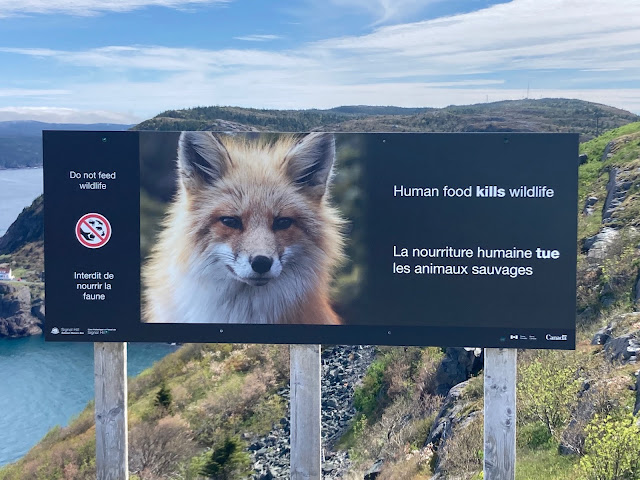














































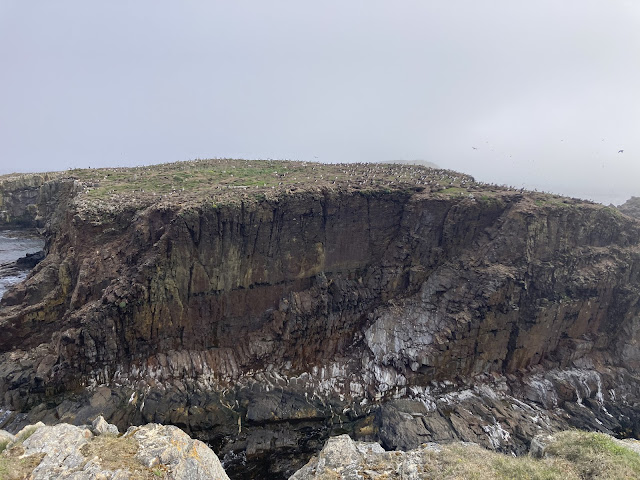










.jpg)

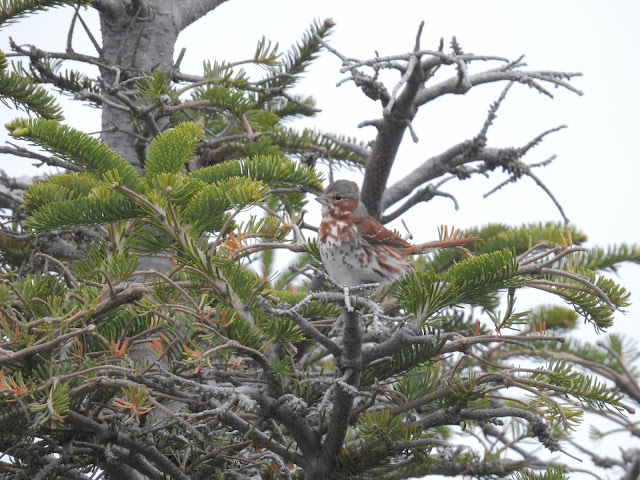

.jpeg)
















































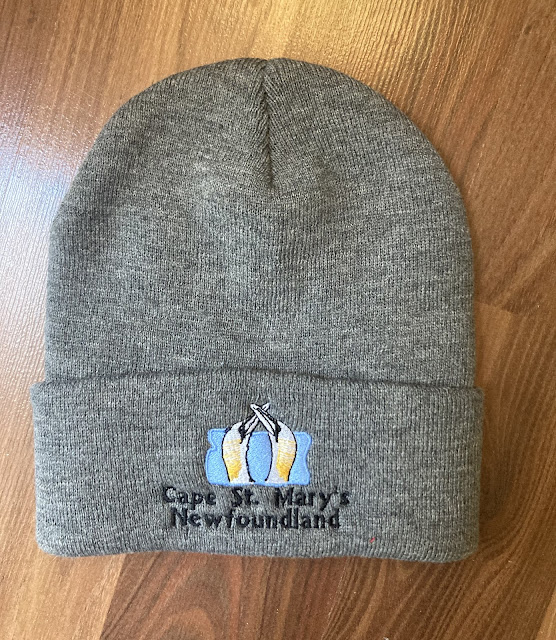

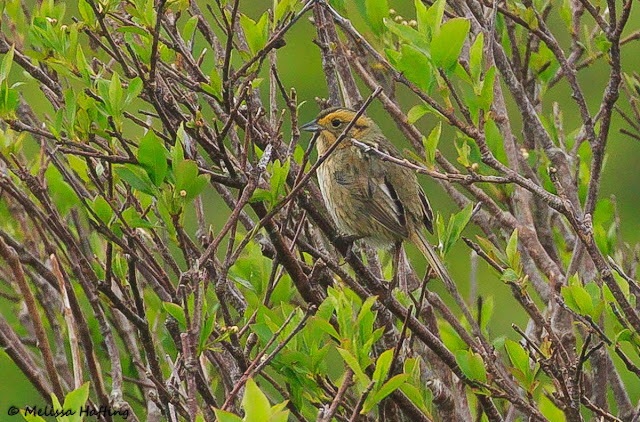
































Sounds like a great trip, beautiful photos!
ReplyDeletesure was thanks!
Deletefantastic pics Mel. can't believe you got the Bicknell's Thrush so beautifully like that well done! makes me want to head out to NFLD and NS !
ReplyDeleteThanks Mike ya seeing the Bicknell's like that was so lucky for sure!
Deletewow Cape St. Mary's looks amazing all those Gannets and the witless bay boat captain makes me laugh
ReplyDeletethanks it was amazing and ya that captain was hilarious
DeleteSounds like it was an awesome trip!
ReplyDeleteIt sure was thanks!
DeleteGreat trip, enjoyable read
ReplyDeleteThanks!
DeleteWhat an exciting trip and a great report! So many exciting birds and experiences! Looking forward to getting caught up properly when I next see you. =)
ReplyDeleteAstonishing photos, as always!
Thanks Jim!! Yes we definitely have to catch up. You really will love NFLD on your visit next year!
Delete